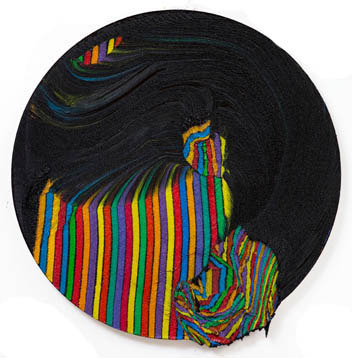Malerei
dal 7/6/2012 al 30/6/2012
Segnalato da
Helen Baker
Phyllida Barlow
Virginia Bodman
Sarah Bowker Jones
Sean Edwards
Alexis Harding
Gabriel Hartley
Natalie Gale
Paul Merrick
Rudolf Polanszky
Sarah Kate Wilson
7/6/2012
Malerei
Transition Gallery, London
Painting As Object. The show investigates painting, as a process, its guises and paint itself as a substance. Each artist shares a love of material and the qualities of 'thing-ness', whether oozing oil paint, found objects, performance or jesmonite, yet avoids slavishness to the visceral by embodying and appropriating particular areas of painting's history.

'If destiny will grant me enough time I shall discover an international language which will endure forever and which will continue to enrich itself…its name will be Malerei [painting].’
Hans K Roethel & Jean K Benjamin, Kandinsky (1979)
Malerei: Painting As Object investigates painting, as a process, its guises and paint itself as a substance. Each artist shares a love of material and the qualities of ‘thing-ness’, whether oozing oil paint, found objects, performance or jesmonite, yet avoids slavishness to the visceral by embodying and appropriating particular areas of painting’s history. Thus revealing a painterly investigation of the modernist concern ‘objecthood’, postmodern eclecticism and the post-production trend of continuous re-working.
A nod to Michael Fried and his essay Art and Objecthood would be appropriate here, however, the artists begin by examining a much earlier concept, Manet’s ‘picture-object’. Michel Foucault stated, ‘And Manet reinvents (or perhaps invents) the picture-object, the picture as materiality… this reinsertion of the materiality of the canvas in that which is represented…’ Manet’s were effectively the first modernist paintings, simply by their honest declaration of painted surfaces using shallow picture depth, large areas of flat blocked-in colour and repetition of verticals and horizontals in composition that reaffirm his canvases axes, consequently drawing the viewers’ attention to the materiality of the work and it’s ‘objectness’.
Harding, Bodman and Gale use paint as a sculptural material in their weighty/lush surfaces while Bowker-Jones almost paints with sculpture, in her colourful jesmonite free-standing compositions. Barlow, Edwards, Merrick, Hartley and Baker’s work realise the power of materials emphasising colour, texture, volume, the presence of a structure, the space around it and the relationship of the viewer to the structure and its environment. Polanzsky and Wilson accept a cross-fertilization that is imperative for ever-evolving heterogeneous practices while revealing their personal efforts to redefine painting through performance and kinetic sculpture.
Preview: Friday 8 June 2012, 6-9pm
Transition Gallery
(Unit 25a Regent Studios) 8 Andrews Road, London
Gallery Open: Fri-Sun 12-6pm
Admission free



